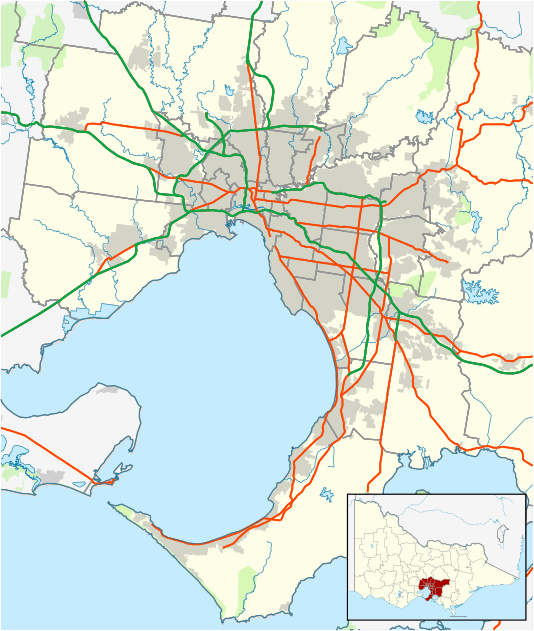Mulgrave, Victoria
| Mulgrave Melbourne, Victoria | |||||||||||||
|---|---|---|---|---|---|---|---|---|---|---|---|---|---|
 Mulgrave Location in metropolitan Melbourne | |||||||||||||
| Coordinates | 37°55′41″S 145°10′26″E / 37.928°S 145.174°ECoordinates: 37°55′41″S 145°10′26″E / 37.928°S 145.174°E | ||||||||||||
| Population | 17,647 (2011 census) | ||||||||||||
| • Density | 1,590/km2 (4,118/sq mi) | ||||||||||||
| Postcode(s) | 3170 | ||||||||||||
| Area | 11.1 km2 (4.3 sq mi) | ||||||||||||
| Location | 21 km (13 mi) from Melbourne | ||||||||||||
| LGA(s) | City of Monash | ||||||||||||
| State electorate(s) | |||||||||||||
| Federal Division(s) | Bruce | ||||||||||||
| |||||||||||||
Mulgrave is a suburb in Melbourne, Victoria, Australia, 21 km south-east of Melbourne's central business district.[1] Its local government area is the City of Monash. At the 2011 Census, Mulgrave had a population of 17,647.[2]
The suburb takes its name from Mulgrave Castle in the County of York. Sir George Phipps, the Earl of Mulgrave in the Peerage of Great Britain would serve as the Governor of Victoria between 1879 and 1884.
Most notably, the suburb gave its name to the Mulgrave Freeway, which was later renamed to the Monash Freeway
History
Mulgrave Parish, as it was then known, was first settled in 1839 by Thomas Napier, a Scottish Builder who first reached the Colony of Victoria in the mid-1830s. Napier settled on the banks of the Dandenong Creek and built his homestead in Bushy Park Wetlands, and what is now Jells Park. None of the original homesteads remain, though some were demolished as late as the latter part of the 20th century. Remains of some homesteads have been uncovered during the construction of the EastLink Tollway, temporarily halting work while they were archaeologically examined.
From Parish to shire
Mulgrave remained a Parish until 19 January 1857 when it, and the neighbouring Parish of Oakleigh were gazetted as the Road District of Mulgrave and Oakleigh respectively. A Mulgrave Post Office opened on 1 January 1869 but was renamed Wheelers Hill in 1888.[3]
On 1 December 1871 further changes saw the two Road Districts merged to become the Shire of Oakleigh. For twenty years Mulgrave effectively ceased to exist until 1891 when, on 13 March, the Shire of Oakleigh was divided to form the Borough of Oakleigh and the Shire of Mulgrave. In 1904 Mulgrave Post Office reopened and closed again in 1956.[3]
Reduction of size
Throughout its history Mulgrave has been plagued by the shifting of its borders and the reduction of its total size. Its borders remained relatively unchanged until 1949 when land was transferred from the Shire to Oakleigh. This occurred again a decade later with the Shire of Mulgrave now reduced to 23 square miles (60 km2). As a part of the changes offices for the Shire were opened in present-day Notting Hill.
Despite such reductions, it was in April 1961 that the Shire saw the biggest reduction in land, when it was gazetted as the City of Waverley. Having been a parish and a shire, Mulgrave was now reduced to a suburb. The third Mulgrave Post Office opened in 1967 and closed in 1978. Meanwhile, a Mulgrave North (later Brandon Park) office opened in 1971, and a Mulgrave East (later Waverley Gardens) office opened in 1978.
Present day
Mulgrave is one of the few Victorian suburbs split into two distinct areas, with each sharing the common name but not prefixing it with ‘East' or ‘West’. This came about as a result of the renaming of parts of Mulgrave to Wheelers Hill, Victoria in the late 1990s. So separated by distance are the two parts that a group local residents from the South Eastern area campaigned, albeit unsuccessfully, in 2004 to have the area renamed to Waverley Park, Victoria.
Greatly reduced in size and presence, Mulgrave is now best known for "Jacksons Road", which runs through the eastern part of the suburb. Jacksons Road is familiar to many Melburnians due to the Jacksons Road Interchange with the Monash Freeway. The Jacksons Road Interchange is a VicRoads timing point for traffic travelling to/from the City.[4] Jacksons Road is a common point of reference for radio news traffic reports when broadcasting travel times into/from the city travelling on the Monash Freeway. Other major points of interest in Mulgrave are the Waverley Gardens Shopping Centre, the Village Green Hotel on the south-west corner of Springvale and Ferntree Gully Roads, the Sunday Mulgrave Farmers' Market on the corner of Jacksons and Wellington Roads, and the former Waverley Park AFL/VFL football ground, now a redeveloped housing estate.
Transport
Metropolitan buses run through this area as well as two popular SmartBus routes and the original hourly services. Most of these bus routes are run by Grenda's Bus Services.[5] now Ventura Bus Lines. [6]
Sport
The suburb has an Australian Rules football team, The Mulgrave Lions, competing in the local Eastern Football League. There is also a Mulgrave Cricket Club and a Mulgrave Junior Cricket Club which compete in both the Eastern cricket association and the southern churches and district association. The Mulgrave lions and the Mulgrave cricket club share the same home ground of Mulgrave reserve which is off Garnett Road. . There is also the St Pauls Cricket Club and the Wellington Tennis Club at Southern Reserve on Police Road, as well as the Mulgrave Country Club Cricket club located at Wellington Reserve.[7]
Education
- Mazenod Secondary College
- Wellington Secondary College
- Albany Rise Primary School
- Mulgrave Primary School
- St John Vianney's Primary School
References
- ↑ http://www.postcodes-australia.com/areas/vic/mulgrave/mulgrave
- ↑ Australian Bureau of Statistics (31 October 2012). "Mulgrave". 2011 Census QuickStats. Retrieved 2012-06-21.
- 1 2 Premier Postal History, Post Office List, retrieved 2008-04-11
- ↑ "VicRoads". Retrieved 2007-10-30.
- ↑ http://www.grenda.com.au/default.php?doc_id=40 Grenda's Route Services
- ↑ http://venturabus.com.au/
- ↑ Full Point Footy, Eastern Football League, retrieved 2008-10-21